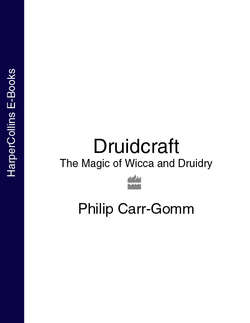Читать книгу Druidcraft: The Magic of Wicca and Druidry - Philip Carr-Gomm - Страница 7
Chapter One A Hidden Valley The Worlds of the Witch & Druid
ОглавлениеEarth and Her stones, shining stars of the night sky,
tumbling rivers, cauldrons, magic, ancient wisdom, strange
hidden beauty, inner knowing, seeing beyond the veil of
Time, knowing that I will return again to Earth after death,
loving my fellow humans, my body and all animals, flying
like a bird to the sun, like a bat to the moon, kissing the
standing stone, drinking from the grail.
Oh that I could see to the Other Realm -
that I could learn the magic of the Ancients.
Oh that the secrets of the Druids and the Witches
could be whispered in my ears
that I might know their beauty and their power -
that I might love again this land
and hear the voices of the Goddess and the God
in the trees and in the rivers.
If you ever travel to Avalon in the south-west of England, you will find, tucked between the crouching beast that is Glastonbury Tor and the rounded breast that is Chalice Hill, a magical garden surrounding a well steeped in legend. Here, between the two hills – one so strongly ‘masculine’ and the other so clearly ‘feminine’ – the well and its garden exude an extraordinary sense of peace and deep resonant power. If you were to enter that garden now you would pass lawns and flower beds, low hedgerows and gnarled yew trees until, following the path that slopes gently upward, you would arrive at the wellhead. And there you would find the well itself, protected by a finely wrought iron cover depicting an ancient symbol – the vesica piscis.
In this symbol, two circles overlap and in doing so create an image which for some depicts Christ, for others the philosopher’s stone, and for yet others the Holy Grail or the sacred vulva of the Goddess. The symbol depicts the union of two principles, two beings, two powers. Each circle remains intact, complete and whole, but where they meet something different and unique is created from their union.
This book takes two worlds which are complete and whole in themselves, and brings them together. It is at the point where they meet that we can, if we wish, find a path of great depth and power.
The worlds that are brought together in this book are those of Witchcraft and Druidry, and I have called the path that they create together Druidcraft, from the Irish word Druidecht, and from the inspiration of the Irish poet W.B. Yeats who uses this term in his poetry.
Many people now practise either Druidry (also known as Druidism) or Wicca (as Witchcraft is often called today) and find within their paths all that they need. Each tradition is complete in itself, and I am not suggesting that either way is incomplete or inadequate. However, over the years I have noticed that many Wiccans have become interested in Druidry, just as many Druids have become interested in Wicca. The fact is that the two circles of Druidry and Wicca now overlap, as many people start to combine their knowledge and experience of each path to fashion their own ‘craft’ – their own spiritual way. For these people the synthesis explored in this book is already happening.
Some time ago there was a real difference between the concerns of Wiccans and Druids. Wiccans were interested in magic and spells, while Druids were more interested in history, the old Celtic myths and a ‘spiritual’ rather than ‘magical’ approach to life. But in the last few years this has changed. Many Wiccans have become interested in the history of the Druids, in Celtic myths, and in Druid animal and tree lore. At the same time, many Druids have become interested in the more intuitive and magical approaches to life that are found in Wicca. If you talk to people who are interested in Wicca or Druidry you will find that most of them are drawn to these spiritual paths for the same reasons.
In the past, subjects and disciplines were kept within defined boundaries. Today, we understand the value of synthesis, synergy and interdisciplinary studies. This is the spirit in which this book is written – to contribute to the field, not to detract from the uniqueness of each approach. I respect both paths deeply and I believe that each is complete in itself, but this does not mean that their relationship and connections cannot be explored, and we may even discover that Wicca and Druidry have gifts to offer that we can combine in creative and beneficial ways.
Most people think that Druidry and Wicca, as they are practised today, represent two streams of pagan tradition that have evolved separately over centuries, or even millennia. In reality, the modern versions of these traditions were originally developed by two friends, Ross Nichols and Gerald Gardner, only 50 years ago. Because of their exchange of ideas and knowledge, the two paths share many similarities and points of connection and, to a great extent, the differences between them are related to the differences between their characters, even though over the last half-century both paths have evolved considerably, creating many different varieties and styles of both Wiccan and Druidic practice.
Druidry and Wicca are now strong and vibrant spiritualities, and if either of them provides you with all that you need, no further exploration is necessary. But if, like me, you can’t resist the urge to explore a hidden valley where two lands meet, then however great the risks, you might well choose to put on your hiking boots, throw a pack on your back and set off!
